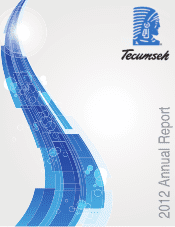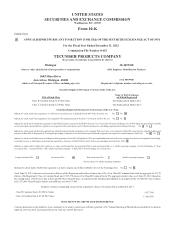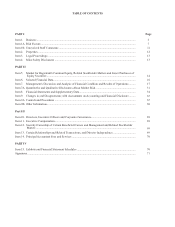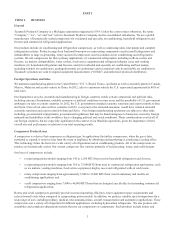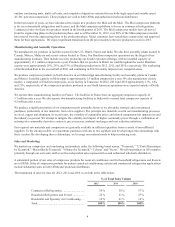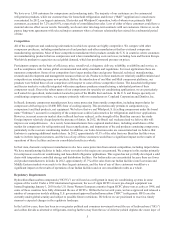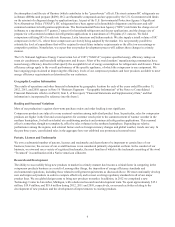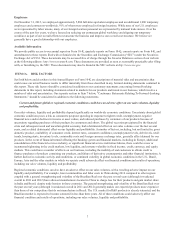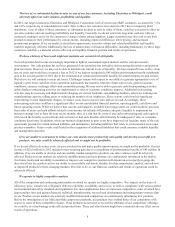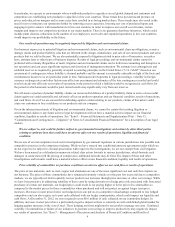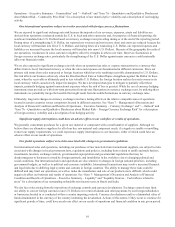Tecumseh Products 2012 Annual Report Download - page 11
Download and view the complete annual report
Please find page 11 of the 2012 Tecumseh Products annual report below. You can navigate through the pages in the report by either clicking on the pages listed below, or by using the keyword search tool below to find specific information within the annual report.10
Operations – Executive Summary – Commodities” and “—Outlook” and “Item 7A – Quantitative and Qualitative Disclosures
about Market Risk – Commodity Price Risk” for a description of raw material price volatility and a description of our hedging
activity.
Our international operations subject us to risks associated with foreign currency fluctuations.
We are exposed to significant exchange rate risk because the majority of our revenues, expenses, assets and liabilities are
derived from operations conducted outside the U.S. in local and other currencies and, for purposes of financial reporting, the
results are translated into U.S. Dollars based on currency exchange rates prevailing during or at the end of the reporting period.
During times of a strengthening U.S. Dollar, our reported net revenues and net income (loss) and assets are reduced because the
local currency will translate into fewer U.S. Dollars, and during times of a weakening U.S. Dollar, our reported expenses and
liabilities are increased because the local currency will translate into more U.S. Dollars. Because of the geographic diversity of
our operations, weaknesses in some currencies might be offset by strengths in others over time. However, fluctuations in
foreign currency exchange rates, particularly the strengthening of the U.S. Dollar against major currencies could materially
affect our financial results.
We are also exposed to significant exchange rate risk when an operation has sales or expense transactions in a currency that
differs from its local, functional currency or when the sales and expenses are denominated in different currencies. Since our
primary risk stems from sales transacted at foreign locations which have the resulting receivable denominated in U.S. Dollars,
this risk affects our business adversely when the Brazilian Real, Euro or Indian Rupee strengthens against the Dollar. In these
cases, when the receivable is ultimately paid in less valuable U.S. Dollars, the foreign location realizes less net revenue in its
local currency, which can adversely impact its margins. We have developed strategies to mitigate or partially offset these
impacts, primarily hedging against transactional exposure where the risk of loss is greatest. While the use of currency hedging
instruments may provide us with short-term protection from adverse fluctuations in currency exchange rates, by utilizing these
instruments we potentially forego the benefits that might result from favorable fluctuations in currency exchange rates.
Ultimately, long term changes in currency exchange rates have lasting effects on the relative competitiveness of operations
located in certain countries versus competitors located in different countries. See “Item 7 – Management’s Discussion and
Analysis of Financial Condition and Results of Operations – Executive Summary – Currency Exchange” and “—Outlook” and
“Item 7A – Quantitative and Qualitative Disclosures about Market Risk – Foreign Currency Exchange Risk” for a description
of foreign currency volatility and a description of our hedging activity.
Significant supply interruptions could have an adverse effect on our cash flow or results of operations.
We generally concentrate purchases for a given raw material or component with a small number of suppliers. Although we
believe there are alternative suppliers for all of our key raw material and component needs, if a supplier is unable or unwilling
to meet our supply requirements, we could experience supply interruptions or cost increases, either of which could have an
adverse effect on our results of operations.
Our global operations subject us to risks associated with changes in government regulations.
Our international sales and operations, including our purchases of raw materials from international suppliers, are subject to risks
associated with changes in local government laws, regulations and policies, including those related to tariffs and trade barriers,
investments, taxation, exchange controls, governmental expropriation and governmental regulations that may be
disadvantageous to businesses owned by foreign nationals, and instabilities in the workforce due to changing political and
social conditions. Our international sales and operations are also sensitive to changes in foreign national priorities, including
government budgets, as well as to political and economic instability. International transactions may involve increased financial
and legal risks due to differing legal systems and customs in foreign countries. The ability to manage these risks could be
difficult and may limit our operations, as well as, make the manufacture and sale of our products more difficult, which could
negatively affect our business and results of operations. See “Item 7– Management’s Discussion and Analysis of Financial
Condition and Results of Operations – Executive Summary – Liquidity” and “Liquidity Sources – Cash inflows related to
taxes” for a description of our outstanding refundable non-income taxes in Brazil and India.
We also face risks arising from the imposition of exchange controls and currency devaluations. Exchange controls may limit
our ability to convert foreign currencies into U.S. Dollars or to remit dividends and other payments by our foreign subsidiaries
or businesses located in or conducted within a country imposing controls. Currency devaluations result in a diminished value of
funds denominated in the currency of the country instituting the devaluation. Actions of this nature, if they occur or continue for
significant periods of time, could have an adverse effect on our results of operations and financial condition in any given period.

